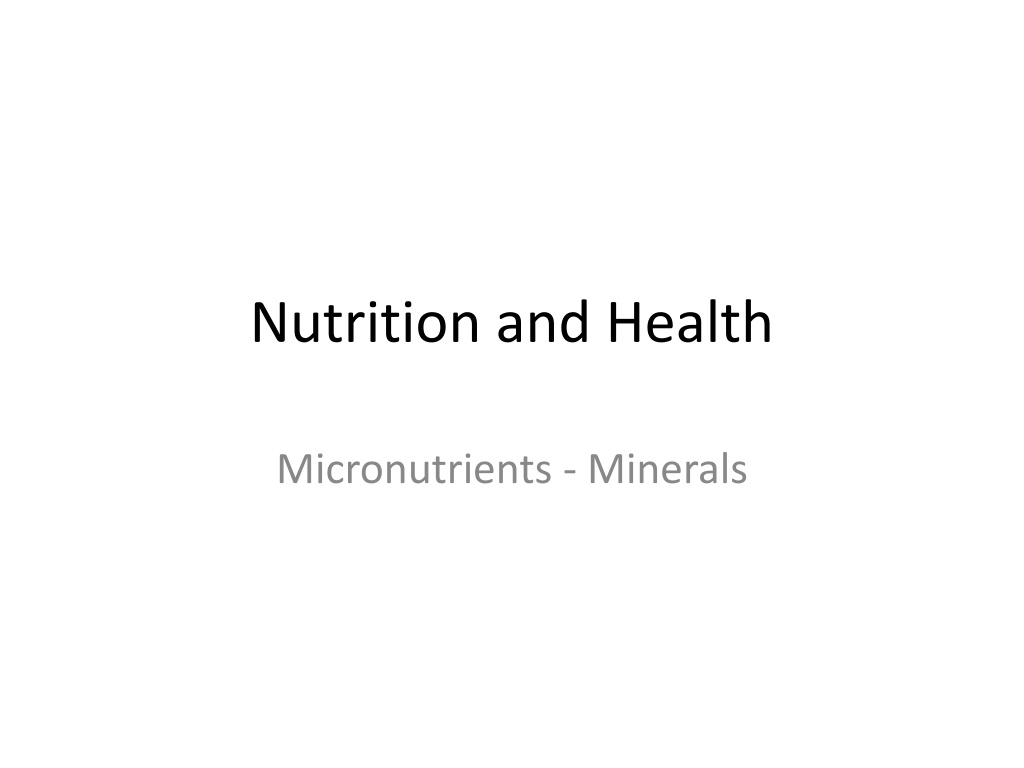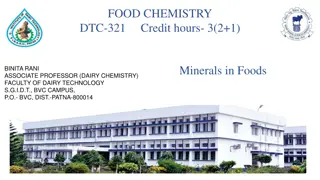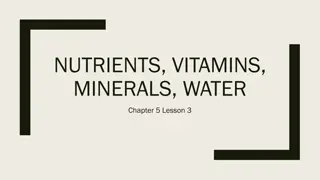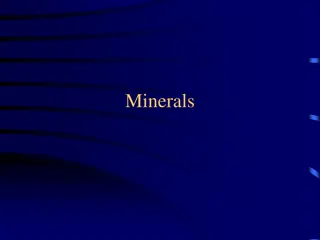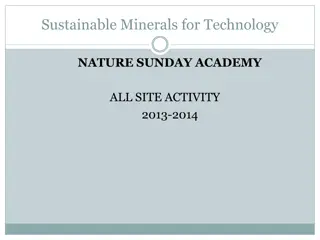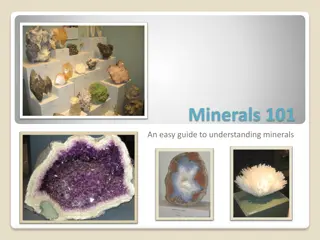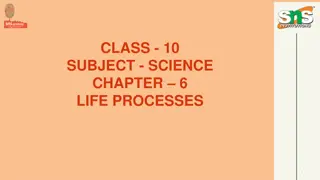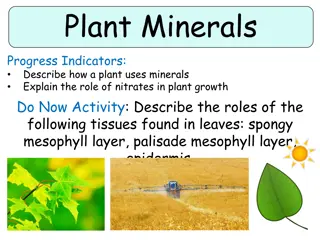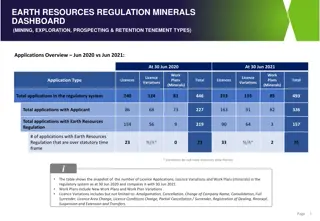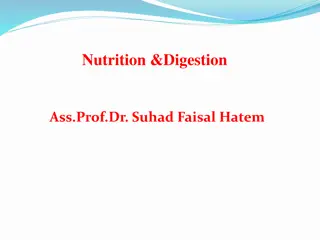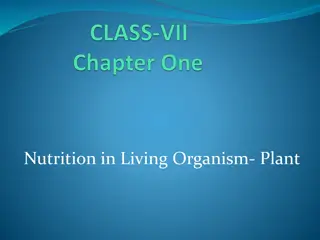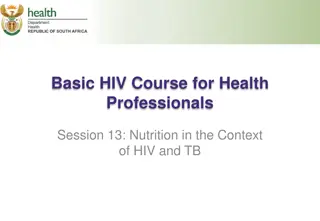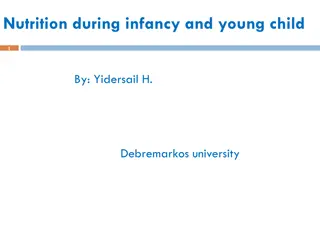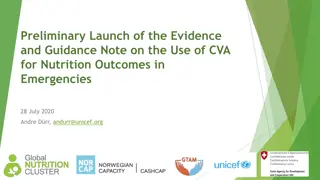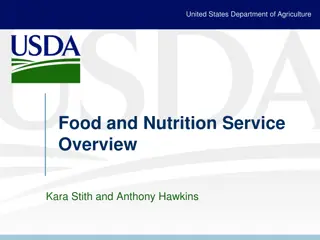Understanding Minerals and Their Importance in Nutrition
Minerals are essential micronutrients required by the human body in small quantities to support various functions, such as bone formation and enzyme secretion. Iron, calcium, sodium, and iodine are crucial minerals with specific roles and food sources. Deficiencies in these minerals can lead to various health issues, emphasizing the importance of a balanced diet to meet daily recommended intake values. Explore the functions, sources, and effects of key minerals like iron to ensure optimal health and well-being.
Download Presentation

Please find below an Image/Link to download the presentation.
The content on the website is provided AS IS for your information and personal use only. It may not be sold, licensed, or shared on other websites without obtaining consent from the author. Download presentation by click this link. If you encounter any issues during the download, it is possible that the publisher has removed the file from their server.
E N D
Presentation Transcript
Nutrition and Health Micronutrients - Minerals
Topics Minerals iron calcium sodium iodine 2
MINERALS 3
Minerals Minerals are micronutrients Human body needs them in very small quantities Minerals are used in the human body to help form bones, skin and tissue and are necessary for many body functions Two minerals most often lacking in the diet are calcium and iron 4
Minerals Sources (Examples) Minerals Functions Deficiency Reference values for adults per day** Iron Forms part of the red blood cell protein, haemoglobin, which carries oxygen around the body Meat, liver, kidneys, some breakfast cereals, fortified bread, green leafy vegetables, dried fruits, pulses Iron-deficiency anaemia may occur, with symptoms of dizziness, pale skin, weakness and tiredness Men: not less than 11.4mg Women: not less than 24.5mg Calcium Important for bones and teeth, muscle contraction, blood clotting and enzyme secretion Milk, cheese, yoghurt, fish that is eaten with the bones (e.g. sardines), green leafy vegetables, nuts, seeds, dried fruits, oranges Too little calcium results in stunted growth and rickets in children, muscle cramps, brittle fingernails, osteoporosis Not less than 1,000mg Sodium Maintains fluid balance. Excess sodium has been associated with raised blood pressure Table salt, salty snacks, fresh meat and poultry, processed foods, condiments and sauces Deficiency in sodium may cause muscle cramps, in serious cases coma and death can result Not more than 2,000mg (i.e. 5g of salt) Iodine Essential part of the thyroid hormones which help to regulate growth and metabolic rate Fish, shellfish, milk and dairy products, fruits, vegetables, cereals Iodine deficiency causes enlargement of the thyroid gland and causes goitre Not less than 150 g and not more than 1,000 g 5 ** Source: Centre for Food Safety, Food and Environmental Hygiene Department
IRON 6
Functions of Iron Iron is needed to make a red-coloured protein called haemoglobin in red blood cells (which is why blood is red) Red blood cells in the blood carry oxygen to body cells 7
Sources of Iron The best sources of iron are found in offal such as liver and kidney Other good sources of iron include: red meat oily fish poultry green leafy vegetables such as broccoli and spinach pulses such as beans and lentils 8
Types of Iron There are two types of iron: Haem iron: more easily absorbed and used by the body found only in animal foods (i.e. meat, poultry, fish and seafood) about half of the iron in animal foods is in the form of haem iron. Non-haem iron: not so easily absorbed by the body plant foods, eggs, milk and dairy products have non-haem iron only also found in animal foods 9
Deficiency of Iron Anaemia (inadequate haemoglobin), caused by lack of iron in the diet, is one of the most common nutritional problems world-wide Women and children are at greatest risk of developing iron deficiency anaemia Vegetarians need to make sure they obtain an adequate iron supply from foods such as cereals, pulses and vegetables 10
Anaemia Shortage of iron intake Inadequate amounts of haemoglobin are formed Blood is unable to carry sufficient oxygen to the cells The body becomes tired easily 11
Anaemia Symptoms of anaemia include: tiredness, weakness, lack of energy a pale complexion, pale inner eyelids brittle fingernails 12
Anaemia Eat plenty of iron-rich foods Iron supplements are only recommended when iron deficiency anaemia actually occurs. * Develop healthy eating habits Prevention of anaemia *Note: If iron supplements are given to young children who have adequate iron stores, growth may be delayed. 13
Iron and Other Nutrients Vitamin C helps the body absorb iron from foods Vitamin C increases the amount of non-haem iron absorbed, so foods containing iron from plant sources should be eaten with foods rich in vitamin C preferably at the same meal 14
CALCIUM 15
Functions of Calcium Calcium helps to form bones and teeth The adult body contains more than 1 kilogram of calcium, most of which is found in the skeleton Calcium is also needed for blood-clotting, muscle contraction and enzyme secretion 16
Sources of Calcium Milk and dairy products such as cheese and yoghurt are important sources of calcium Bean curd and soya bean products are good sources of calcium in Asian diet Other foods that are also good sources of calcium include: green, leafy vegetables nuts, seeds and dried fruits fish that is eaten with the bones, such as sardines 17
Sources of Calcium Amount of calcium (mg) per 100 grams of edible portion 1200 1000 800 600 400 200 0 Source: Centre for Food Safety, Food and Environmental Hygiene Department 18
Deficiency of Calcium Inadequate dietary calcium will cause some calcium from the bones to move to the blood. Poor intake of calcium will cause less calcium deposition in the bones, and will result in a lower bone mass and a weaker skeleton. Calcium deficiency can also cause rickets in children, though rickets is more commonly associated with vitamin D deficiency. If a pregnant woman does not have enough calcium in her diet, calcium will be removed from her bones and transmitted to the unborn baby to enable the bones of the baby to grow. This will weaken the woman s bones and teeth. 19
Osteoporosis Osteoporosis is the condition of weakening and thinning of the bones. It is more common in elderly people, especially women. Inadequate calcium deposition in the bones Weakening and thinning of the bones Osteoporosis The bones fracture and break easily 20
Osteoporosis Regular exercise, especially weigh- bearing exercise A diet with a good supply of calcium, particularly during childhood and the teenage years Avoidance of smoking and drinking excessive amount of alcohol Protect against osteoporosis 21
Calcium and Other Nutrients Vitamin D is needed, together with calcium and phosphorus, to help build and maintain strong bones and teeth Vitamin C helps in the absorption of calcium. Magnesium is essential for absorption and metabolism of calcium 22
SODIUM 23
Functions of Sodium Sodium is essential for normal body functions It helps maintain the extra-cellular fluid balance and acid-base balance in the body It is required for nerve transmission and muscle contraction 24
Sources of Sodium Most raw foods contain a very small amount of sodium Sodium is found in sodium bicarbonate which is a raising agent in baked foods such as cakes and biscuits The most common form of sodium in the diet is salt (sodium chloride) salt comprises 40% sodium and 60% chloride (1g of sodium chloride (NaCl) contains about 393mg of sodium) During the processing, preparation, preservation and serving of foods, salt is added salt is added in foods to enhance taste and flavour (e.g. enhance sweetness, mask metallic tastes) salt can also: prevent microbial growth extend product shelf life improve the product texture (e.g. control the stickiness of doughs, improve the tenderness of leaner cuts of meat) Source: Centre for Food Safety, Food and Environmental Hygiene Department 25
Sources of Sodium (contd) Salt is added to foods, for example: condiments and sauces (e.g. soya sauce, oyster sauce, monosodium glutamate (MSG) and stock powder/cubes, salad dressing and ketchup) processed vegetable products (e.g. preserved leaf mustard, preserved mustard, preserved cabbage) processed meat products (e.g. roast pork, sausages, meat balls, preserved fish and seafood, salted eggs) snacks (e.g. crisps, salted nuts/seeds, preserved fruits, dried/preserved meat snacks, preserved seafood snacks) instant foods (e.g. instant noodles, canned soup) 26
Deficiency of Sodium Sodium deficiency can be seen in people who work or take part in sports in very hot conditions Chronic conditions like kidney failure or heart failure may also cause loss of sodium from the body 27
Deficiency of Sodium Work or take part in sports in very hot conditions Sickness and diarrhoea The body loses sodium through sweating The body loses too much sodium Headache, confusion, decreased consciousness, coma and death Muscle cramps 28
Excess of Sodium Excessive sodium intake can be detrimental to health, such as increasing the risk of developing hypertension, which in turn increases the risk of coronary heart diseases and stroke Salt and salt-preserved food items may also increase the risk of stomach cancer The World Health Organization (WHO) recommends a maximum daily sodium intake of 2,000mg, i.e. 5g of salt Source: Centre for Food Safety, Food and Environmental Hygiene Department 29
Excess of Sodium Kidneys are responsible for regulating the amount of sodium in the body Some people are more sensitive to sodium; they tend to retain sodium more easily and may have higher risk of developing hypertension Low sodium level in the body: Kidneys conserve sodium High sodium level in the body: Excrete the excess amount through urination Source: Centre for Food Safety, Food and Environmental Hygiene Department 30
Excess of Sodium Excessive sodium intake Kidneys cannot excrete enough sodium Sodium and fluid retention Hypertension Increase the risk of coronary heart disease and stroke Source: Centre for Food Safety, Food and Environmental Hygiene Department 31
Ways to Reduce Dietary Intake of Sodium Change dietary habits by reducing the amount of salt or sodium-containing seasonings added to food Use natural ingredients (e.g. garlic, ginger, lemon/lime juice, parsley) to replace seasonings and sauce Read nutrition labels and choose food with lower sodium content Reduce the intake of processed food Reduce dietary intake of sodium (salt) Source: Centre for Food Safety, Food and Environmental Hygiene Department 32
Salt Reduction in Prepackaged Foods by Product Reformulation Source: Centre for Food Safety, Food and Environmental Hygiene Department 33
IODINE 34
Functions of Iodine Iodine is needed to make thyroid hormones in the thyroid gland Thyroid gland is located in the neck Thyroid hormones control the metabolic rate of the body the rate at which chemical reactions take place inside the body 35
Sources of Iodine Iodine is found in seafood, such as saltwater fish seaweed (including kelp, nori) shellfish Iodine is also found in milk and dairy products as well as some plant foods, depending on the iodine content of the soil where cattle are grazed or plants are grown 36
Deficiency of Iodine The person will feel tired, lethargic (does not want to do anything) and will gain weight The thyroid gland in the neck will swell up to form a goitre 37
Deficiency of Iodine Inadequate intake of iodine Thyroid tries to keep up with demand for thyroid hormone production Thyroid progressively enlarges Development of a goitre Symptoms of choking, and difficulty in swallowing and breathing 38
Deficiency of Iodine Taking iodine supplement* Introduction of iodised salt (only in North America) Eating foods high in iodine Prevent against iodine deficiency *A supplement for the most susceptible groups pregnant and lactating women and children 7- 24 months of age assessment is necessary * Source: Joint Statement by the WHO and the United Nations Children s Fund, 2007 Reaching Optimal Iodine Nutrition in Pregnant and Lactating Women and Young Children 39
References Centre for Food Safety, Food and Environmental Hygiene Department - Nutrients Definition and Function. Centre for Food Safety, Food and Environmental Hygiene Department Nutrient Information Inquiry. Centre for Food Safety, Food and Environmental Hygiene Department Report of study on sodium content in local foods. Centre for Food Safety, Food and Environment Hygiene Department Reduction of Dietary Sodium and Sugar. Centre for Food Safety, Food and Environmental Hygiene Department Food Safety Express (for Food Trade). Centre for Food Safety, Food and Environmental Hygiene Department (2012) . Study on Sodium Content in Local Foods (Rep. No. 49). Insel, P. M., Ross, D., McMahon, K., & Bernstein, M. (2019). Discovering nutrition. Burlington, MA: Jones & Bartlett Learning. Otten, J. J., Hellwig, J. P., & Meyers, L. D. (2006). Dietary reference intakes: The essential guide to nutrient requirements. Washington, D.C.: National Academies Press. Reaching Optimal Iodine Nutrition in Pregnant and Lactating Women and Young Children. (2007). Joint Statement by the World Health Organization and the United Nations Children s Fund 40
